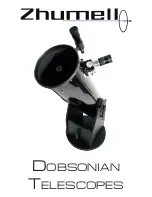
15 / 20
Dark adaptation
Allow your eyes to get used to the darkness. This dark adaptation lasts about 15 to 20 minutes and
starts anew after each - even short - light disturbance. Use a lamp with a red filter, e.g. to read maps
or work on the telescope. Weak red light hardly disturbs the dark adaptation of the eyes.
Observations through a window
Observing through a closed window is very unfavourable. The light collected by the telescope must
penetrate several layers of glass or air, which leads to considerable image disturbances.
Observation time and magnification
Planets and other objects, when close to the horizon, are strongly influenced by air turbulence and ex-
tinction. Here it is always worthwhile to place the observation at a time when they are as high as pos-
sible in the sky. Switch to an eyepiece with a lower magnification when the image is flickering or
cloudy. Choosing a magnification that is too high is a mistake that is very common in beginners.
Garments
Even in summer it can get very cool on clear nights, especially in the mountains. Take warm clothing
such as sweaters, hats, gloves, thicker socks, etc. with you to the observation site. Even in the most
beautiful night, observing is no fun when you are cold!
Observation site
Explore their observation site by day. It should be located away from roads and other light sources
that would prevent dark adaptation. Fog can often form near rivers or lakes at night. The surface
should be firm and relatively level. Although one can also observe from the cities, a place further away
is recommendable. Really good sky conditions often only exist about 50 km away from big cities or
conurbations. There's an old astronomer's saying: "A dark sky cannot be replaced by anything but a
darker sky!"
20 Cleaning and maintenance
NOTICE
Never remove mirror elements!
Correct reassembly without specialist knowledge is not possible. The result is a considerable reduc-
tion in optical performance. In this case the warranty claim is void!
NOTICE
Do not use aggressive cleaning agents!
Do not use photographic lens cleaners and no perfume-impregnated, dyed or lotion-soaked cloths to
clean optical surfaces. By the use the optics can take permanently damage!
• Protect the device from dust and moisture!
• Avoid fingerprints and similar contamination of the optical surfaces.
• The residual moisture must be completely degraded before use.
• Do not clean the optics too often! A little dust on the front of the lens or mirror surface will not signi-
ficantly reduce the image quality. This is no reason for cleaning.
• If necessary, carefully remove dust on the front of the lens or mirror surface with a camel hair
brush or blow away with compressed air.
• Remove organic soiling (e.g. fingerprints) with a cleaning liquid (mixing ratio: three parts distilled
water, one part isopropyl alcohol). Add a small drop of biodegradable dishwashing detergent per
half liter of cleaning liquid. Use soft, white face tissues and carefully clean surfaces with short, ra-
dial wiping movements. Replace the tissues as often as possible.
Summary of Contents for 0116950
Page 1: ...Manual_0116950_UL Dobson 20_en_title pdf 1 18 08 2020 13 56 03...
Page 17: ......
Page 18: ......
Page 19: ......






































